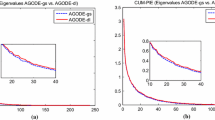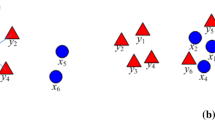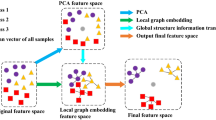Abstract
Graph embedding plays an important role in dimensionality reduction for processing the high-dimensional data. In graph embedding, its keys are the different kinds of graph constructions that determine the performance of dimensionality reduction. Inspired by this fact, in this article we propose a novel graph embedding method named the double graphs-based discriminant projections (DGDP) by integrating two designed discriminative global graph constructions. The proposed DGDP can well discover the discriminant and geometrical structures of the high-dimensional data through the informative graph constructions. In two global graph constructions, we consider the geometrical distribution of each point on each edge of the graphs to define the adjacent weights with class information. Moreover, in the weight definition of one graph construction, we further strengthen pattern discrimination among all the classes to design the weights of the corresponding adjacent graph. To demonstrate the effectiveness of the proposed DGDP, we experimentally compare it with the state-of-the-art graph embedding methods on several data sets. The experimental results show that the proposed graph embedding method outperforms the competing methods with more power of data representation and pattern discrimination in the embedded subspace.








Similar content being viewed by others
Explore related subjects
Discover the latest articles, news and stories from top researchers in related subjects.Notes
References
Belhumeur PN, Hespanha JP, Kriegman DJ (1997) Eigenfaces versus Fisherfaces: recognition using class specific linear projection. IEEE Trans Pattern Anal Mach Intell 19(7):711–720
He X, Yan S, Hu Y (2005) Face recognition using laplacianfaces. IEEE Trans Pattern Anal Mach Intell 27(3):328–340
Gao Q, Xu S, Chen F, Ding C (2018) \(R_{1}\)-2-DPCA and face recognition. IEEE Trans Cybern 49(4):1212–1223
Lu Y, Yuan C, Li X (2018) Structurally incoherent low-rank 2DLPP for image classification. IEEE Trans Circuits Syst Video Technol 29(6):1701–1714
Li W, Feng F, Li H (2018) Discriminant analysis-based dimension reduction for hyperspectral image classification: a survey of the most recent advances and an experimental comparison of different techniques. IEEE Geosci Remote Sens Mag 6(1):15–34
Feng F, Li W, Du Q, Zhang B (2017) Dimensionality reduction of hyperspectral image with graph-based discriminant analysis considering spectral similarity. Remote Sens 9(4):323. https://doi.org/10.3390/sr9040323
Li W, Du Q (2016) Laplacian regularized collaborative graph for discriminant analysis of hyperspectral imagery. IEEE Trans Geosci Remote Sens 54(12):7066–7076
Li W, Liu J, Du Q (2016) Sparse and low rank graph-based discriminant analysis for hyperspectral image classification. IEEE Trans Geosci Remote Sens 54(7):4094–4105
Kim K (2018) An improved semi-supervised dimensionality reduction using feature weighting: application to sentiment analysis. Expert Syst Appl 109:49–65
Ma Y, Wu X (2018) Discriminant sparse and collaborative preserving embedding for bearing fault diagnosis. Neurocomputing 313:259–270
Yan S, Xu D, Zhang B (2007) Graph embedding and extensions: a general framework for dimensionality reduction. IEEE Trans Pattern Anal Mach Intell 29(1):40–51
Lai Z, Xu Y, Yang J (2017) Rotational invariant dimensionality reduction algorithms. IEEE Trans Cybern 47(11):3733–3746
Goyal P, Ferrara E (2018) Graph embedding techniques, applications, and performance: a survey. Knowl Based Syst 151:78–94
Cai H, Zheng V, Chang K (2017) A comprehensive survey of graph embedding: problems, techniques and applications. IEEE Trans Knowl Data Eng 30(9):1616–1637
Turk M, Pentland A (1991) Face recognition using eigenfaces. In: computer vision and pattern recognition, pp 586–591
Martinez A, Kak A (2001) PCA versus LDA. IEEE Trans Pattern Anal Mach Intell 23(2):228–233
He X, Niyogi P (2003) Locality preserving projections. In: neural information processing systems, pp 153–160
Lai Z, Xu Y, Chen Q, Yang J (2014) Multilinear sparse principal component analysis. IEEE Trans Neural Netw Learn Syst 25(10):1942–1950
Smallman L, Artemiou A, Morgan J (2018) Sparse generalised principal component analysis. Pattern Recognit 83:443–455
Mi J, Zhang Y, Lai Z, Li W (2019) Principal component analysis based on nuclear norm minimization. Neural Netw 118:1–16
Wen J, Fang X, Cui J, Fei L (2019) Robust sparse linear discriminant analysis. IEEE Trans Circuits Syst Video Technol 29(2):390–403
Wan H, Wang H, Guo G (2017) Separability-oriented subclass discriminant analysis. IEEE Trans Pattern Anal Mach Intell 40(2):409–422
Zheng S, Ding C, Nie F (2019) Harmonic mean linear discriminant analysis. IEEE Trans Knowl Data Eng 31(8):1520–1531
Lu Y, Lai Z, Xu Y, Li X, Zhang D (2015) Low-rank preserving projections. IEEE Trans Cybern 46(8):1900–1913
Zhang H, Wu QJ, Chow TW, Zhao M (2012) A two-dimensional neighborhood preserving projection for appearance-based face recognition. Pattern Recognit 45(5):1866–1876
Wang S, Xin Y, Kong D (2018) Unsupervised learning of human pose distance metric via sparsity locality preserving projections. IEEE Trans Multimedia 21(2):314–327
Chen W, Li C, Shao Y, Zhang J (2019) 2DRLPP: Robust two-dimensional locality preserving projection with regularization. Knowl Based Syst 169:53–66
Zhang W, Xue X, Lu H (2006) Discriminant neighborhood embedding for classification. Pattern Recognit 39(11):2240–2243
Gou J, Yi Z (2013) Locality-based discriminant neighborhood embedding. Comput J 56(9):1063–1082
Ding C, Zhang L (2015) Double adjacency graphs-based discriminant neighborhood embedding. Pattern Recognit 48(5):1734–1742
Wang S, Ding C (2018) Dimensionality reduction via preserving local information. Future Gener Comput Syst. https://doi.org/10.1016/j.future.2018.01.016
Wong W, Zhao H (2012) Supervised optimal locality preserving projection. Pattern Recognit 45(1):186–197
Gao Q, Liu J, Zhang H, Gao X, Li K (2013) Joint global and local structure discriminant analysis. IEEE Trans Inf Forens Secur 8(4):626–635
Wang R, Nie F, Hong R (2017) Fast and orthogonal locality preserving projections for dimensionality reduction. IEEE Trans Image Process 26(10):5019–5030
Yang Z, Huang P, Wan M (2018) Discriminant maximum margin projections for face recognition. Multimedia Tools Appl 78(17):23847–23865
Hajizadeh R, Aghagolzadeh A, Ezoji M (2020) Local distances preserving based manifold learning. Expert Syst Appl 139:112860
Yi Y, Wang J, Zhou W (2019) Joint graph optimization and projection learning for dimensionality reduction. Pattern Recognit 92:258–273
Xu Y, Zhong A, Yang J (2010) LPP solution schemes for use with face recognition. Pattern Recognit 43(12):4165–4176
Wright J, Yang AY, Ganesh A (2008) Robust face recognition via sparse representation. IEEE Trans Pattern Anal Mach Intell 31(2):210–227
Zhang L, Yang M, Feng X (2011) Sparse representation or collaborative representation: Which helps face recognition?. In: International conference on computer vision (ICCV2011), pp 471–478
Qiao L, Chen S, Tan X (2010) Sparsity preserving projections with applications to face recognition. Pattern Recognit 43(1):331–341
Gui J, Sun Z, Jia W (2012) Discriminant sparse neighborhood preserving embedding for face recognition. Pattern Recognit 45(8):2884–2893
Yuan S, Mao X, Chen L (2019) Sparsity regularization discriminant projection for feature extraction. Neural Process Lett 49(2):539–553
Gao Q, Wang Q, Huang Y (2015) Dimensionality reduction by integrating sparse representation and fisher criterion and its applications. IEEE Trans Image Process 24(12):5684–5695
Gou J, Du L, Cheng K (2016) Discriminative sparsity preserving graph embedding. In: IEEE congress on evolutionary computation, pp 4250–4257
Gou J, Yi Z, Zhang D (2018) Sparsity and geometry preserving graph embedding for dimensionality reduction. IEEE Access 6:75748–75766
Yin J, Lai Z, Zeng W (2018) Local sparsity preserving projection and its application to biometric recognition. Multimedia Tools Appl 77(1):1069–1092
Yang W, Wang Z, Sun C (2015) A collaborative representation based projections method for feature extraction. Pattern Recognit 48(1):20–27
Yin J, Wei L, Song M (2016) Optimized projection for collaborative representation based classification and its applications to face recognition. Pattern Recognit Lett 73:83–90
Hua J, Wang H, Ren M (2017) Collaborative representation analysis methods for feature extraction. Neural Comput Appl 28(1):225–231
Yuan M, Feng DZ (2019) Dimensionality reduction by collaborative preserving Fisher discriminant analysis. Neurocomputing 356:228–243
Huang P, Li T, Gao G (2018) Collaborative representation based local discriminant projection for feature extraction. Digital Signal Process 76:84–93
Acknowledgements
This work was supported in part by National Natural Science Foundation of China (Grant Nos. 61976107, 61672268, 61962010 and 61502208), International Postdoctoral Exchange Fellowship Program of China Postdoctoral Council (No. 20180051), Research Foundation for Talented Scholars of JiangSu University (Grant No. 14JDG037), Open Foundation of Artificial Intelligence Key Laboratory of Sichuan Province (Grant No. 2017RYJ04), Application Foundation of Sichuan Province (Grant No. 2018JY0386) Natural Science Foundation of Guizhou Province (Nos.[2017]1130 and [2017]5726-32), Natural Science Foundation of Ningxia of China (No. 2019AAC03122), and Key Science and Research Project of North Minzu University (No. 2019KJ43).
Author information
Authors and Affiliations
Corresponding author
Ethics declarations
Conflict of interest
All the authors declare that there is no conflict of interests regarding the publication of this article.
Additional information
Publisher's Note
Springer Nature remains neutral with regard to jurisdictional claims in published maps and institutional affiliations.
Rights and permissions
About this article
Cite this article
Gou, J., Xue, Y., Ma, H. et al. Double graphs-based discriminant projections for dimensionality reduction. Neural Comput & Applic 32, 17533–17550 (2020). https://doi.org/10.1007/s00521-020-04924-5
Received:
Accepted:
Published:
Issue Date:
DOI: https://doi.org/10.1007/s00521-020-04924-5




